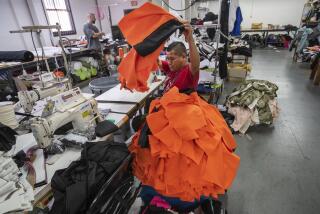December Business Inventories Rose Only Slightly
- Share via
WASHINGTON — Businesses, coping with dampened demand, managed to keep a lid on inventories in December, a government report indicated Wednesday.
The Commerce Department said the value of inventories of goods on shelves and back lots rose by a tiny 0.1% to a seasonally adjusted $1.22 trillion. The increase was the smallest in nearly two years. Sales of goods also rose a slight 0.1% in December to $896.8 billion.
To bring inventories more in line with demand, companies are laying off workers, reducing shifts to curb production and deeply discounting merchandise.
“The big December production cuts were successful in reining in the growth of inventories,” said economist Ken Mayland, president of ClearView Economics. “While wholesalers may be a bit ahead in the adjustment process, retailers and manufacturers are clearly not sleeping at the switch. All are making progress.”
Federal Reserve Chairman Alan Greenspan told Congress on Tuesday that the economic slowdown over the last several months was more sudden than most businesses anticipated. That, he said, resulted in a “backup in inventories despite the more advanced just-in-time technologies that have in recent years enabled firms to adjust production levels more rapidly to changes in demand.”
Greenspan appeared to be cautiously optimistic about the prospects for more healthy economic growth later this year, economists said.
Robert Ferguson, vice chairman of the Fed’s Board of Governors, said Wednesday that the economy “is clearly undergoing a stock adjustment” to bring supply and demand for goods into better alignment.
The inventory-to-sales ratio, which measures how long it would take businesses to exhaust their inventories at December’s sales pace, remained at 1.36 months, suggesting that businesses were still holding excess supplies. The ratio had risen to 1.36 months in November, the highest since April 1999.
Economist Clifford Waldman, president of Waldman Associates, said if reports over the next several months show weaker growth in inventories, particularly in stockpiles of costly manufactured goods, such as cars, that could be a good sign that the production cutback in manufacturing is coming to an end.
More to Read
Inside the business of entertainment
The Wide Shot brings you news, analysis and insights on everything from streaming wars to production — and what it all means for the future.
You may occasionally receive promotional content from the Los Angeles Times.










